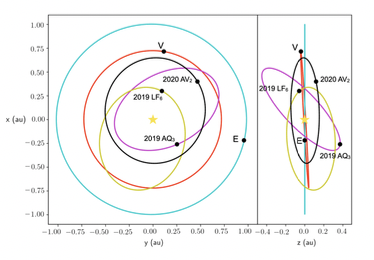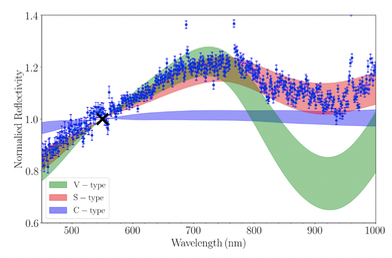The Discovery and Characterization of the First Inner-Venus Asteroid, 2020 AV2
- 1Division of Physics, Mathematics and Astronomy, Caltech, Pasadena, CA 91125, USA
- 2IPAC, Mail Code 100-22, Caltech, 1200 E. California Blvd., Pasadena, CA 91125, USA
- 3Institute of Astronomy, National Central University, Taoyuan City, Taiwan
The Discovery and Characterization of the First Inner-Venus Asteroid, 2020 AV2
Bryce T. Bolin (1,2), Wing-Huen Ip (3), Frank J. Masci (2), George Helou (2)
(1) Div. of Physics, Mathematics and Astronomy, Caltech, Pasadena, CA 91125, USA (bbolin@caltech.edu)
(2) IPAC, Mail Code 100-22, Caltech, 1200 E. California Blvd., Pasadena, CA 91125, USA
(3) Institute of Astronomy, National Central University, Taoyuan City, Taiwan
Before 2019, almost all 1 million known, less than two dozen were on orbits located within the Earth’s orbit with none being entirely within the orbit of Venus. Here we report the discovery of the first inner-Venus asteroid (IVA), 2020 AV2, was first detected by the Zwicky Transient Facility (ZTF) on the Samuel Oschin Telescope (Bellm et al. 2019) on 2020 January 4 (Bolin et al. 2020). Additional data obtained with the Spectral Energy Distribution Machine (SEDM) on the Palomar 60-inch telescope (Blagorodnova et al 2018) on 2020 January 8 and the Kitt Peak Electron Multiplying CCD Demonstrator (KPED) mounted on the Kitt Peak 84-inch telescope (Coughlin et al. 2019) on 2020 January 9 confirmed the orbit with an aphelion distance of ~0.65 au confirming the discovery of the first inner-Venus asteroid (Fig 1., left panel). The orbit was further refined by subsequent observations by other facilities by 2020 January 23 resulting in the orbital elements, a = 0.55, e = 0.18, I = 15.88 degrees, Ω = 6.71 degrees, ω = 187.31 degrees and M = 275.35 degrees. In addition, the spectra of 2020 AV2 revealed by Keck telescope observations on 2020 January 23 indicate a reddish surface corresponding to colors of g-r ~ 0.65 and r – i ~ 0.23 mag and an absorption band at ~900 nm resulting in a i-z ~ 0.11 mag (Fig. 1., right panel). Comparing with the Bus-DeMeo spectroscopic classification shows that the spectra of 2020 AV2 most resembles a S-type spectrum (DeMeo et al. 2009) with origin from the inner Main Belt where S-type asteroids are most plentiful (DeMeo et al. 2014). Assuming a S-type albedo of ~0.2, this results in an estimated diameter of ~1.5 km. In addition to our determined orbit, we compare our detection of 2020 AV2 to NEO population models and analyze its orbital evolution and history.
References: Bolin, et al. 2020, Minor Planet Electronic Circulars, 2020-A99., Bellm et al. 2019, PASP, 131, 6., Blagorodnova et al 2018, PASP, 130, 985., Coughlin et al. 2019, MNRAS, 485, 1412-1419., DeMeo et al. 2009, Icarus, 202, 160-180., DeMeo et al. 2014, Nature, 505, 629-634.


Figure 1. Left panel: Orbital configuration of 2020 AV2 (black line), Earth (blue line) and Venus (Red line at the time of its discovery looking from above the orbital plane of the inner Solar System. The orbits of 2019 AQ3 and 2020 LF6 are plotted for reference. Right panel: Visible wavelength reflectance spectrum taken of 2020 AV2 with the LRIS instrument on Keck I on 2020 January 23 plotted as blue dots. The spectrum has been normalized to unity at 550 nm indicated by the black cross. The 1 σ uncertainties are indicated by the error bars on the datapoints. The spectral range of S, V and C-type asteroids from the Bus-DeMeo asteroid taxonomic catalog (DeMeo et al. 2009) are over-plotted with the S-type spectrum most closely resembling the spectra of 2020 AV2.
How to cite: Bolin, B., Ip, W.-H., Masci, F., and Helou, G.: The Discovery and Characterization of the First Inner-Venus Asteroid, 2020 AV2, Europlanet Science Congress 2020, online, 21 September–9 Oct 2020, EPSC2020-482, https://doi.org/10.5194/epsc2020-482, 2020

